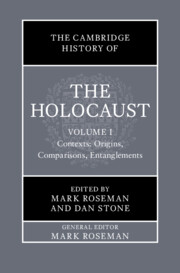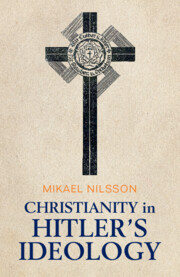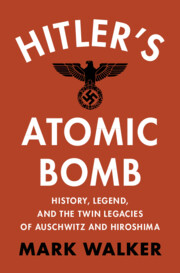Refine search
Actions for selected content:
76 results
4 - The Holocaust, Genocide, and the Origins of the Commensurability Problem
-
-
- Book:
- The Cambridge History of the Holocaust
- Published online:
- 16 May 2025
- Print publication:
- 12 June 2025, pp 74-92
-
- Chapter
- Export citation
Introduction to Volume I
-
-
- Book:
- The Cambridge History of the Holocaust
- Published online:
- 16 May 2025
- Print publication:
- 12 June 2025, pp 8-19
-
- Chapter
- Export citation
General Editor’s Introduction
-
-
- Book:
- The Cambridge History of the Holocaust
- Published online:
- 16 May 2025
- Print publication:
- 12 June 2025, pp 1-7
-
- Chapter
- Export citation

The Cambridge History of the Holocaust
-
- Published online:
- 16 May 2025
- Print publication:
- 12 June 2025
11 - Race in the Global History of Europe
-
-
- Book:
- Globalizing Europe
- Published online:
- 06 March 2025
- Print publication:
- 13 March 2025, pp 159-180
-
- Chapter
- Export citation
3 - The Rise and Fall of the Great Changemakers
-
- Book:
- The Greatest of All Time
- Published online:
- 23 January 2025
- Print publication:
- 06 March 2025, pp 81-121
-
- Chapter
- Export citation
Chapter 8 - On German Culture and Post-war Re-education
-
- Book:
- Otto Neurath in Britain
- Published online:
- 09 January 2025
- Print publication:
- 23 January 2025, pp 208-231
-
- Chapter
- Export citation
2 - Masters of Men and Beasts: The Early Roman Fantasia of Ownership
- from Part I - Masters of Men and Beasts
-
- Book:
- From Masters of Slaves to Lords of Lands
- Published online:
- 28 November 2024
- Print publication:
- 16 January 2025, pp 75-124
-
- Chapter
- Export citation
3 - The Dominus Enters the Law
- from Part I - Masters of Men and Beasts
-
- Book:
- From Masters of Slaves to Lords of Lands
- Published online:
- 28 November 2024
- Print publication:
- 16 January 2025, pp 125-159
-
- Chapter
- Export citation
4 - Racism in Hitler’s Shadow
- from Part II - Kicking out the Turks
-
- Book:
- Foreign in Two Homelands
- Published online:
- 31 August 2024
- Print publication:
- 31 October 2024, pp 177-226
-
- Chapter
-
- You have access
- Open access
- HTML
- Export citation
How a Nazi occupied India’s first chair in International Relations
-
- Journal:
- Review of International Studies / Volume 51 / Issue 2 / March 2025
- Published online by Cambridge University Press:
- 30 October 2024, pp. 219-236
- Print publication:
- March 2025
-
- Article
-
- You have access
- Open access
- HTML
- Export citation

Christianity in Hitler's Ideology
- The Role of Jesus in National Socialism
-
- Published online:
- 31 August 2024
- Print publication:
- 27 June 2024

Hitler's Atomic Bomb
- History, Legend, and the Twin Legacies of Auschwitz and Hiroshima
-
- Published online:
- 18 July 2024
- Print publication:
- 18 July 2024
8 - Compromising with Hitler
- from Part II - Living with the Bomb
-
- Book:
- Hitler's Atomic Bomb
- Published online:
- 18 July 2024
- Print publication:
- 18 July 2024, pp 179-214
-
- Chapter
- Export citation
10 - Copenhagen
- from Part II - Living with the Bomb
-
- Book:
- Hitler's Atomic Bomb
- Published online:
- 18 July 2024
- Print publication:
- 18 July 2024, pp 240-267
-
- Chapter
- Export citation
3 - Christ on the Crooked Cross, Part II
-
- Book:
- Christianity in Hitler's Ideology
- Published online:
- 31 August 2024
- Print publication:
- 27 June 2024, pp 134-159
-
- Chapter
- Export citation
Conclusion
-
- Book:
- Christianity in Hitler's Ideology
- Published online:
- 31 August 2024
- Print publication:
- 27 June 2024, pp 234-242
-
- Chapter
- Export citation
1 - Christ on the Crooked Cross, Part I
-
- Book:
- Christianity in Hitler's Ideology
- Published online:
- 31 August 2024
- Print publication:
- 27 June 2024, pp 32-84
-
- Chapter
- Export citation
5 - Jesus as an Ideological Inspiration for Hitler and the NSDAP
-
- Book:
- Christianity in Hitler's Ideology
- Published online:
- 31 August 2024
- Print publication:
- 27 June 2024, pp 180-233
-
- Chapter
- Export citation
Introduction
-
- Book:
- Christianity in Hitler's Ideology
- Published online:
- 31 August 2024
- Print publication:
- 27 June 2024, pp 1-31
-
- Chapter
- Export citation
